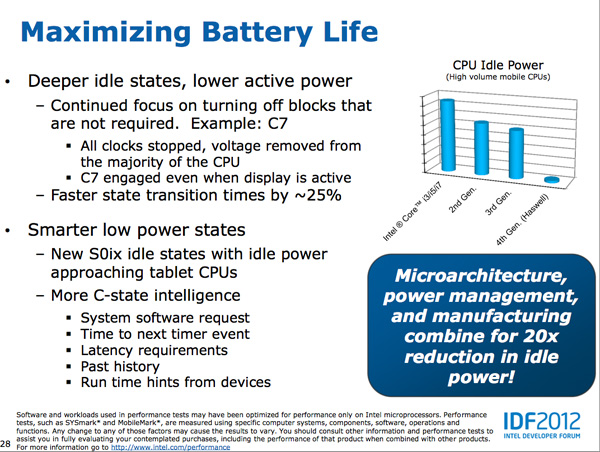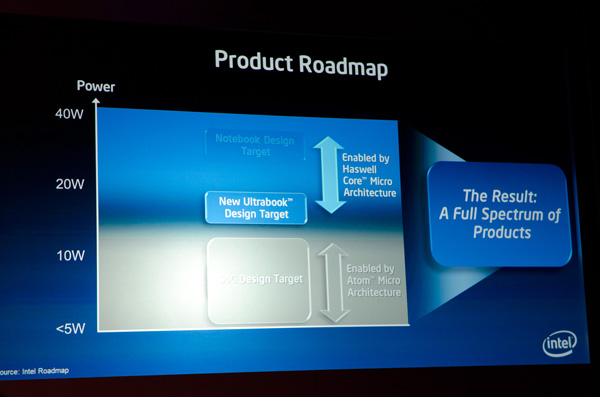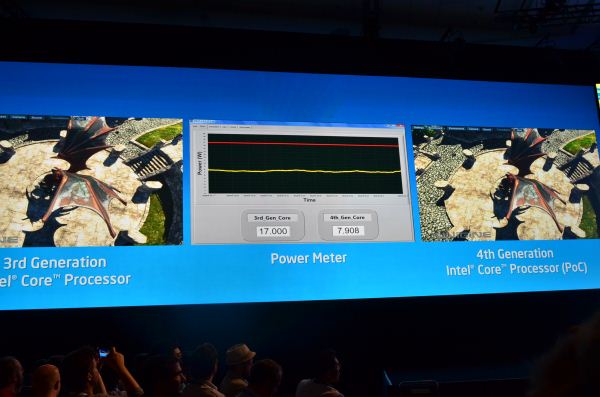Intel's Haswell Architecture Analyzed: Building a New PC and a New Intel
by Anand Lal Shimpi on October 5, 2012 2:45 AM ESTOther Power Savings
Haswell's power savings come from three sources, all of which are equally important. We already went over the most unique: Intel's focus on reducing total platform power consumption by paying attention to everything else on the motherboard (third party controllers, voltage regulation, etc...). The other two sources of power savings are more traditional, but still very significant.

At the micro-architecture level Intel added more power gating and low power modes to Haswell. The additional power gating gives the power control unit (PCU) more fine grained control over shutting off parts of the core that aren't used. Intel published a relatively meaningless graph showing idle power for standard voltage mobile Haswell compared to the previous three generations of Core processors.
Haswell can also transition between power states approximately 25% faster than Ivy Bridge, which lets the PCU be a bit more aggressive in which power state it selects since the penalty of coming out of it is appreciably lower. It's important to put the timing of all of this in perspective. Putting the CPU cores to sleep and removing voltage/power from them even for a matter of milliseconds adds up to the sort of savings necessary to really enable the sort of always-on, always-connected behavior Haswell based systems are expected to deliver.
Intel has also done a lot of work at the process level to bring Haswell's power consumption down. As a tock, Haswell is the second micro-architecture to use Intel's new 22nm tri-gate transistors. The learnings from Ivy Bridge are thus all poured into Haswell. Intel wasn't too specific on what it did on the manufacturing side to help drive power down in Haswell other than to say that a non-insignificant amount of work came from the fabs.
The Fourth Haswell
At Computex Intel's Mooly Eden showed off this slide that positioned Haswell as a 15-20W part, while Atom based SoCs would scale up to 10W and perhaps beyond:
Just before this year's IDF Intel claimed that Haswell ULT would start at 10W, down from 17W in Sandy/Ivy Bridge. Finally, at IDF Intel showed a demo of Haswell running the Unigen Heaven benchmark at under 8W:
The chain of events tells us two things: 1) Intel likes to play its cards close to its chest, and 2) the sub-10W space won't be serviced by Atom exclusively.
Intel said Haswell can scale below 10W, but it didn't provide a lower bound. It's too much to assume Haswell would go into a phone, but once you get to the 8W point and look south you open yourself up to fitting into things the size of a third generation iPad. Move to 14nm, 10nm and beyond then it becomes more feasible that you could fit this class of architecture into something even more portable.
Intel is being very tight lipped about the fourth client Haswell (remember the first three were desktop, mobile and ultra-low-volt/Ultrabook) but it's clear that it has real aspirations to use it in a space traditionally reserved for ARM or Atom SoCs.
One of the first things I ever heard about Haswell was that it was Intel's solution to the ARM problem. I don't believe a 10W notebook is going to do anything to the ARM problem, but a sub-8W Haswell in an iPad 3 form factor could be very compelling. Haswell won't be fanless, but Broadwell (14nm) could be. And that could be a real solution to the ARM problem, at least outside of a phone.
As I said before, I don't see Haswell making it into a phone but that's not to say a future derivative on a lower power process wouldn't.













245 Comments
View All Comments
tipoo - Sunday, October 7, 2012 - link
I don't think so, doesn't the HD4000 have more bandwidth to work with than AMDs APUs yet offers worse performance? They still had headroom there. I think it's just for TDP, they limit how much power the GPUs can use since the architecture is oriented at mobile.magnimus1 - Friday, October 5, 2012 - link
Would love to hear your take on how Intel's latest and greatest fares against Qualcomm's latest and greatest!cosmotic - Friday, October 5, 2012 - link
Ah, an MPEG2 encoder. Just in time!jamyryals - Friday, October 5, 2012 - link
This made me :)name99 - Friday, October 5, 2012 - link
We laugh but one possibility is that Intel hopes to sell Haswell's inside US broadcast equipment.There isn't much broadcast equipment sold, but the costs are massive, and there's no obvious reason not to replace much of that custom hardware with intel chips.
And much of the existing broadcast hardware (at least the MPEG2-encoding part) is obviously garbage --- the artifacts I see on broadcast TV are bad even for the prime-time networks, and are truly awful for the budget independent operators.
Much like they have written a cell-tower stack to run on i7's to replace the similarly grossly over-priced custom hardware that lives in cell towers, and are currently deploying in China. Anand wrote about this about two weeks ago.
vt1hun - Friday, October 5, 2012 - link
Do you have an idea when Intel will move to DDR4 ? Not with Haswell according to this article.Thank you
tipoo - Friday, October 5, 2012 - link
Haswell EX for servers will support DDR4, but even Broadwell on desktops is only DDR3, we won't see DDR4 in desktops until 2015.jwcalla - Friday, October 5, 2012 - link
We'll probably see DDR4 in the ARM space before we have it on Intel.Maybe this should be AMD's focus of attack: if they can't compete on performance, at least try on chipset features.
Perhaps Intel's biggest concern would be if somebody comes along with a super-efficient x86 emulator for ARM. Going forward, "legacy applications" is going to be an increasingly important selling point to prevent ARM inroads on the low end.
Microsoft keeping their Windows ARM version locked-down is a key to that too, and likely a deference to their relationship with Intel. But Apple is less likely to similarly constrain themselves.
meloz - Saturday, October 6, 2012 - link
>We'll probably see DDR4 in the ARM space before we have it on Intel.>Maybe this should be AMD's focus of attack: if they can't compete on performance, at least try on chipset features.
The problem with DDR4 is likely going to be the price. We all know how the memory industry likes to jack up the prices whenever a new spec comes out. Remember how expensive DDr3 was when it started to replace DDR2?
Some people joke that this transition is the only time they make any money in the RAM business, and considering the low prices of DDR3 you have to wonder.
DDR4 might offer some performance and power advantage on release, but it will likely be more expensive and take time (12-18 months?) to offer a compelling performance / $ advantage over cheap DDR3 variants.
If AMD is trying to position itself as 'value' brand, chaining themselves to DDR4 (before Intel's volume brings down the prices for everyone) could spell their doom.
Kevin G - Friday, October 5, 2012 - link
Intel is set to launch Ivy Bridge EX on a new socket late in 2013 on a new socket. The on-die controller will likely use memory buffering similar to what Nehalem-EX and Westmere-EX use. The buffer chips may initially use DDR3 but this would allow for a trivial migration to DDR4 since the on-die controller doesn't communicate directly with the memory chips.Come to think of it, Intel could migration Nehalem-EX/Westmere-EX to DDR4 with a chipset upgrade. Vendors like HP put the buffer chips and memory slots on a daughter card so only that part would need replacement.